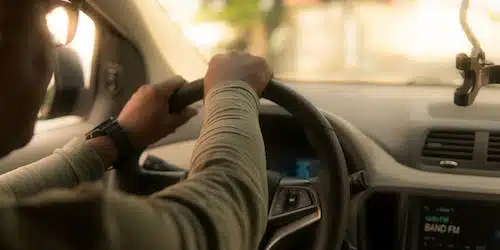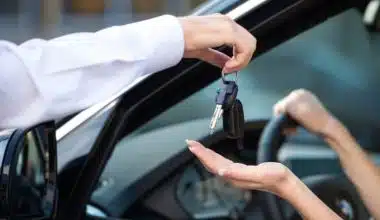To drive for Uber, there are certain requirements you need to meet, including age, legal residency, and valid documentation. Check vehicle requirements, sign up, choose the right ride option, obtain necessary licenses and permits, understand earnings and expenses, and maintain a high driver rating. Uber offers various ride options, and drivers can earn money based on trips and fares. Understanding these requirements and maintaining a high rating can lead to more ride requests and better earning opportunities. You can read more about this in this article.
How To Drive For Uber
To drive for Uber, you need to meet certain requirements and follow a few steps. Here is a step-by-step guide on how to drive for Uber
Step 1: Check the Minimum Requirements
Most people can drive with Uber, but the requirements may vary by city. Minimum requirements for driving include meeting the age requirement, being legally allowed to drive in your country, having valid documentation, providing proof of residency in your city or province, and having a driver profile photo.
Step 2: Check Vehicle Requirements
Uber has specific vehicle requirements that vary by city and ride option. For example, for UberX, the vehicle must be a 4-door vehicle with independently opening passenger doors, have 5 factory-installed seats and seat belts, working windows and air conditioning, and no vans. The eligible vehicle models may also depend on factors like the year of manufacture and ride option availability in your city.
Step 3: Sign Up with Uber
Visit the Uber website or download the Uber app from your app store. Sign up as a driver and provide the required information, including your details, driver’s license, and vehicle information. Complete the background check process, which may include a criminal record check and a driving history check. Once approved, you will receive instructions on how to activate your account and start driving.
Step 4: Choose the Right Vehicle Option
Uber offers different ride options, such as UberX, UberXL, Uber Black, and Uber Select. Research and choose the ride option that suits your vehicle and preferences. Some options may require specific vehicle models, such as luxury cars for Uber Black.
Step 5: Get the Necessary Licenses and Permits
Depending on your location, you may need to obtain additional licenses or permits to drive for Uber. Check with your local transportation authority or Uber’s website to determine if any additional permits are required.
Step 6: Understand Earnings and Expenses
Uber drivers can earn money based on the number of trips they complete and the fares they receive. The amount you can earn may vary depending on factors such as location, time of day, and demand. It’s important to consider expenses such as gas, taxes, and car maintenance when calculating your earnings.
Step 7: Maintain a High Driver Rating
Uber uses a rating system where riders can rate their experience with drivers. Maintain a high driver rating by providing excellent service, being punctual, and ensuring a smooth and enjoyable ride for your passengers. Higher ratings can lead to more ride requests and better earning opportunities.
Step 8: Take Advantage of Incentives and Promotions
Uber often offers incentives and promotions to drivers to encourage them to drive during specific times or in certain areas. Keep an eye on the Uber driver app for any such incentives or promotions that you can take advantage of to maximize your earnings.
Step 9: Optimize Your Driving Strategy
To maximize your earnings, consider driving during peak hours or in areas with high demand. Familiarize yourself with popular destinations in your city and stay up-to-date with local events or promotions that can increase demand for rides.
Step 10: Understand Tax Obligations
As an independent contractor, you are responsible for your taxes. Keep track of your earnings and expenses related to your Uber driving. Consult with a tax professional to understand your tax obligations and ensure you are properly reporting your income.
How To Drive For Uber Eats
To drive for Uber Eats, follow these steps:
#1. Check if Uber Eats is Available in your City
UberEats offers food delivery driver opportunities in major cities across the US, including Austin, Boston, Chicago, Houston, Los Angeles, Miami, New York City, San Francisco, and Seattle, as well as hundreds of other cities, large and small, around the country.
#2. Meet the Requirements
To drive for Uber Eats, you need to meet certain requirements, which may vary by location. Generally, you must be at least 18 years old, have a valid driver’s license, and have a reliable vehicle (car, bike, or scooter).
#3. Sign Up
If you already have an active driver account with Uber, you can simply turn on UberEats in your app settings to start receiving delivery requests. If you don’t have an Uber driver account, you can sign up through the Uber Eats website or app.
#4. Understand the Delivery Process
Familiarize yourself with the Uber Eats app and how it works. The app will show you available delivery requests in your area. Accept delivery requests based on your availability and location. Use the app’s navigation feature to reach the restaurant for pickup and the customer for drop-off.
#5. Choose your Vehicle
UberEats allows you to deliver using a car, bike, or scooter. The specific requirements for each mode of transportation may vary, so make sure to check the requirements for your chosen vehicle type.
#6. Set your Availability
As an Uber Eats driver, you have the flexibility to choose when you want to deliver. You can drive for an hour, a weekend, or throughout the week, depending on your schedule and preferences.
#7. Manage Your Deliveries
Use the Uber Eats app to manage your deliveries, track your earnings, and access support if needed. Communicate with customers through the app’s messaging feature if there are any issues or questions regarding the delivery.
#8. Get Paid
Uber Eats offers quick and convenient payment options. You can get paid for each delivery you complete, and you have the option to cash out your earnings instantly using Uber’s Instant Pay feature.
#9. Maximize your Earnings
To earn more as an Uber Eats driver, you can take advantage of boost incentives, which are location-based incentives that can increase your earnings during peak times or in specific areas. Additionally, you can consider multi-mapping, which means running more than one delivery app at a time to increase your opportunities for trip requests.
#10. Explore Additional Opportunities
UberEats offers partnerships with restaurants, grocery stores, and other businesses. If you own a business, you can become an Uber Eats partner and expand your customer base. Stay updated with any new features, promotions, or changes in the UberEats app to make the most of your delivery experience.
How To Drive For Uber Without A Car
If you don’t have a car but still want to drive for Uber, there are options available to you. Here are a few ways to drive for Uber without owning a car:
#1. Rent A Car Through Uber
Uber offers rental programs in partnership with various vehicle rental companies. These programs allow you to rent a car specifically for driving with Uber. You can choose from hourly or weekly rental options, depending on your needs.
#2. Drive for UberEats
If you’re interested in food delivery rather than passenger transportation, you can become an Uber Eats driver. UberEats does not require you to own a vehicle, so you can use alternative forms of transportation such as a bike or scooter to make deliveries.
#3. Uber Conecta
In some locations, Uber offers a program called Uber Conecta, which connects drivers with car owners who are willing to let them use their vehicles. This program allows you to drive with the Uber app using someone else’s car.
#4. Rent A Car Through A Third-Party Rental Service
Apart from Uber’s rental programs, several third-party companies offer car rental services specifically for rideshare drivers. These companies may have more flexible rental options and pricing plans.
#5. Use A Car-Sharing Service
Car-sharing services such as Getaround, Turo, or Zipcar allow you to rent a car from individuals in your area. These services often offer hourly or daily rental options, making it convenient for Uber drivers who only need a vehicle for specific periods.
#6. Borrow A Car From A Friend Or Family Member
If you have a friend or family member who is willing to let you use their car, you can consider borrowing their vehicle to drive for Uber. However, it’s important to note that you will need to comply with Uber’s requirements and ensure that the car meets all the necessary criteria, such as age, model year, and insurance coverage.
#7. Partner With A Local Fleet Owner
In some cities, there are fleet owners who own multiple vehicles and hire drivers to operate them. These fleet owners may provide the vehicle, maintenance, and insurance, allowing you to drive for Uber without owning a car.
#8. Consider Alternative Modes Of Transportation
If you live in a city with good public transportation or have access to a bike or scooter, you can become an Uber Eats delivery partner. Uber Eats allows you to make deliveries using these alternative modes of transportation, providing an opportunity to earn money without needing a car.
How To Drive For Uber With A Bad Driving Record
If you have a bad driving record, it can be challenging to drive for Uber. The company conducts background and driving record checks, and a history of traffic violations, accidents, or serious offenses may disqualify you. There are restrictions on the number of moving violations and accidents allowed within a certain time frame. If you believe there has been an error, you may have the option to appeal. Correcting any errors on your driving record can also help.
Challenges On How To Drive For Uber With A Bad Driving Record
Here are some of the main challenges you may face:
#1. Disqualification
Uber conducts background and driving record checks, and a history of traffic violations, accidents, or serious offenses may disqualify you from driving for these platforms. Each company has specific criteria and restrictions regarding driving records, and they reserve the right to disqualify drivers based on safety-related reasons.
#2. Limited Opportunities
With a bad driving record, you may have limited options for driving with Uber. These companies prioritize passenger safety and may be hesitant to onboard drivers with a history of violations or accidents. This can make it more difficult to find driving opportunities and earn income through these platforms.
#3. Higher Insurance Costs
If you have a bad driving record, you may face higher insurance costs. Uber requires drivers to have personal auto insurance that meets certain requirements. However, insurance providers may charge higher premiums for drivers with a history of violations or accidents, which can impact your overall expenses as a rideshare driver.
#4. Increased Scrutiny
Drivers with bad driving records may face increased scrutiny from passengers and may receive more complaints or negative ratings. This can affect your overall driver rating and potentially lead to deactivation if the issues persist.
#5. Limited Appeal Options
If you are denied or suspended from driving for Uber due to your driving record, the appeal process may be challenging. While there may be options to appeal the decision, the outcome is not guaranteed, and the process can be time-consuming and require substantial evidence or representation.
#6. Increased Risk of Deactivation
Uber and other rideshare platforms prioritize passenger safety. If you have a bad driving record, you may be at a higher risk of receiving complaints or negative feedback from passengers. Consistently low ratings or a significant number of complaints can lead to deactivation from the platform, further impacting your ability to drive and earn income.
#7. Difficulty Securing Auto Financing or Leasing
If you have a bad driving record, it may be more challenging to secure auto financing or leasing options for a vehicle. Lenders and leasing companies typically consider your driving record as part of their assessment process. A bad driving record can result in higher interest rates, stricter terms, or even the denial of financing or leasing altogether.
#8. Stress and Anxiety
Driving for Uber with a bad driving record can bring additional stress and anxiety. You may constantly worry about maintaining a clean driving record, avoiding further violations, and providing a safe and comfortable experience for passengers. This added pressure can impact your overall driving experience and personal well-being.
How To Drive For Uber A Dui
Driving for Uber with a DUI (Driving Under the Influence) can be challenging, as Uber has strict policies regarding criminal offenses on a driver’s record. Here are some key points to consider:
#1. Uber’s Policy
Uber generally does not allow individuals with a DUI conviction within the past seven years to drive on their platform. This policy is in place to prioritize passenger safety and maintain the company’s standards.
#2. Background Checks
Uber conducts background checks on all prospective drivers, which include a review of criminal records. A DUI conviction is likely to appear on a background check and may result in disqualification from driving for Uber.
#3. Jurisdiction-Specific Regulations
The regulations regarding DUI convictions and rideshare driving can vary by jurisdiction. Some areas may have stricter rules, while others may have more lenient requirements. It’s important to check the specific regulations in your location to understand the implications of a DUI conviction on your eligibility to drive for Uber.
#4. Appealing a Denial
In some cases, it may be possible to appeal a denial based on a DUI conviction. However, the outcome of an appeal is not guaranteed, and the process can be complex and time-consuming.
#5. Expungement of Record Sealing
Expunging or sealing a DUI conviction from your record may improve your chances of being approved as an Uber driver. However, the availability and requirements for expungement of record sealing vary by jurisdiction, so it’s important to consult with a legal professional familiar with the laws in your area.
#6. Safety Features
Uber has implemented safety features in its app to help prevent drunk driving incidents. For instance, the app includes an emergency button that connects drivers directly with 911 in case of emergencies.
#7. Impact on Insurance
Having a DUI on your record can significantly impact your auto insurance rates. Insurance providers may consider drivers with a DUI conviction as high-risk, leading to higher premiums or even difficulty in obtaining coverage.
#8. Legal Implications
DUI convictions can have various legal consequences, including fines, license suspensions, mandatory alcohol education programs, and potential jail time. It’s crucial to understand and comply with the legal requirements and restrictions related to DUI convictions in your jurisdiction.
How Much Does An Uber Driver Make?
The earnings of an Uber driver can vary depending on factors such as location, hours worked, demand, and expenses. On average, Uber drivers can expect to make between $15 and $25 per hour before expenses. However, actual earnings can vary significantly. Additional factors such as tips, surge pricing, and promotions can increase earnings during peak demand periods. It’s important to consider expenses such as fuel costs, vehicle maintenance, and insurance, as drivers are responsible for covering these costs.
How Much Is Uber Registration?
There is no specific fee for registering as an Uber driver. The registration process involves meeting certain requirements and providing necessary documentation, such as a valid driver’s license, proof of residency, and proof of vehicle insurance. There may be location-specific requirements and costs associated with becoming an Uber driver. It’s important to consider expenses such as vehicle maintenance, fuel costs, and insurance, as these are typically the responsibility of the driver.
How Do I Join Uber For Rides?
To join Uber for rides, download the app, create an account, enter your pickup location, choose a ride option, confirm your request, track your ride on the app’s map, receive driver details, and enjoy your ride. Payments will be processed automatically through the app. The steps may vary depending on your location and app version.
Do You Get Paid Daily With Uber?
Uber offers multiple payment options for drivers, including Instant Pay and Flex Pay, which allow drivers to cash out their earnings daily. Additionally, Uber also provides the option for drivers to set up weekly direct deposits to their bank accounts. The availability of these payment options may vary by location.
How Much Does Bolt Take From Drivers?
Bolt charges a commission of 15% to 20% of the final price per order, depending on the city. This commission fee applies to both cash and card rides, as well as cancellation fees. However, the commission does not apply to tips, bonuses, or additional airport or toll fees. The commission is automatically calculated and deducted from the drivers’ weekly earnings. The exact percentage may vary depending on the location.
Conclusion
Uber offers various ways for non-car owners to drive for the company. These include renting a car through Uber, driving for Uber Eats, using Uber Conecta, or renting a car through third-party rental services, which may have more flexible options. Driving for Uber with a bad driving record can be challenging due to background checks, limited opportunities, and higher insurance costs. Appeals and correcting errors can help mitigate these challenges. Uber’s strict policies prohibit driving with a DUI within seven years, requiring background checks and jurisdiction-specific regulations.
- IS THERE UBER IN ITALY? All You Need To Know
- WHY IS UBER SO EXPENSIVE? All You Need To Know
- IS THERE UBER IN PARIS? All You Need To Know
- CAN YOU ORDER AN UBER FOR SOMEONE ELSE?






